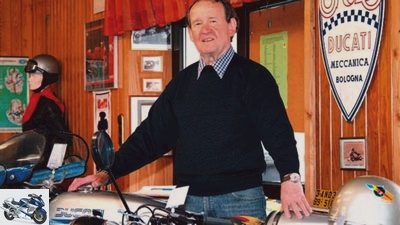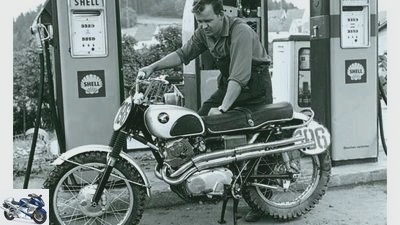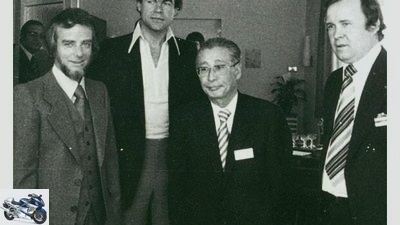Table of contents

Winni washer
Sports & scene
Portrait: two-wheeler dealer Fritz Roth
scene
Portrait of Fritz Roth
Content of
Fritz Roth has dedicated himself to the motorcycle business for 50 years. As an importer, he holds the brand record, even Moto Guzzi, Ducati and Suzuki are on his list.
Winni washer
05/14/2010
The three most important factors for the success of a business are location, location and again location. According to this wisdom, Hammelbach in the Odenwald should definitely be avoided as a location. For motorcyclists, however, this place has long been at the center of the cosmos, especially for the Italo faction.
Fritz Roth ran his two-wheeler business in Hammelbach: “Italian motorcycles have always been different from NSU, Horex and BMW, different from the English and Americans anyway. That is why we imported everything from Aermacchi to Benelli, Bimota, Ducati, Moto Morini to Moto Guzzi and sold them through dealers across Germany. We were always a point of contact, some customers just came by for a chat, others bought spare parts or brought their vehicle to an inspection. Many experienced the greatest moment when they picked up their new machine from us. The location was never a disadvantage, on the contrary: Many of our customers liked to go to the Odenwald and combined their visit with us with a motorcycle tour.”
To this day, former customers like to come by to say hello or to take a look at the small, fine vintage car collection. Whenever he can, the boss personally takes care of his visitors. He can tell something about every machine, but he is more cautious about the history of his business: “From when to when we imported or distributed which brand, I don’t know by heart. My co-workers took care of the bureaucracy; I was and am a technology fan.” There are reasons for Fritz Roth’s down-to-earth attitude. The Roth family business was founded in 1873 as a general store. Fritz, born in 1939, grew up between groceries, sewing machines, garden tools, bicycles and a gas station with a workshop. The Roths repair what the people bring; They are the authorized dealers for NSU motorcycles.
“I was particularly interested in motorcycles. I clearly remember my first test drive across our neighbour’s meadow. I was eleven years old, the motorcycle was a 98 anchor with a Fichtel & Sachs two-stroke. Then it was clear to me: when I grow up, I’ll be a motorcycle racer.” In the 1950s, more motorcycles were produced in the Federal Republic of Germany than anywhere else, with over 2.2 million machines registered. However, this stock slipped to 415,000 by the mid-1960s; the promised economic miracle changes the market more radically than any scrapping bonus. Those who respect themselves wear a hat, drive a car and stay clean. He looks at the poor pigs on their stinking mills with pity, disrespect or suspicion. NSU, a few years earlier still world market leader in motorcycle construction, bluntly expressed it in 1966: “NSU will never build motorcycles again, the future belongs to the car.”

Archive Roth
Motorcycles from the Honda brand were also for sale at Fritz Roth or in the workshop.
Fritz Roth has now completed his training in his parents’ company, and he is also a motorcycle racer: He successfully participates in off-road competitions – first with a 125cc NSU, later on the 250 NSU Max. but the dream of the works driver is not coming true. During the week the motorcycle business has to be kept going, he can’t make a living from racing alone. Despite all the prognoses, Fritz Roth believes in the motorcycle.
In the spring of 1960, the Hamburg motorcycle dealer Karl Heinz Meller brought the first Hondas to Germany. A little later, the Japanese machines are also in Hammelbach. “Compared to German brands, the Hondas looked very exotic. Few believed the high-revving two-cylinder four-stroke engines could do anything, after all, so much could break. Then who should repair the motorcycle and how? Where do I get the spare parts from? The surprise was all the greater when the motors worked like clockworks and almost didn’t break. A new age had dawned.”
Anyone who wants to sell motorcycles in the 1960s needs ideas. Fritz Roth specializes in Italian athletes. In the van he brings Ducati, Moto Morini, Aermacchi and Benelli machines to the Odenwald, takes care of the TuV approval, ensures the service and the supply of spare parts. From 1964 he is the official Moto Guzzi importer for Germany. “That sounded great, but the standard was high. We had to work a lot, build up a dealer network and maintain the parts warehouse in-house. We also had to organize service, warranty processing and bookkeeping.
Nevertheless, it always happened that something didn’t work out. When spare parts were not delivered, I took our van to Moto Guzzi in Mandello. I was already known then; what we needed was loaded straight from the assembly line, and then the mail went back home. Again and again we found technical details on the motorcycles that could be improved. We proposed our ideas to the plant and they almost always flowed into series production. It was a huge challenge, but it was fun.”

Archive Roth
Important visit to Roth: Ernst Degner, Dieter Braun and Jitsujiro Suzuki in person.
In the autumn of 1966 Fritz Roth reads a test report about the Suzuki T20 in Das MOTORRAD, according to Ernst Leverkus “the fastest 250 cc series machine that I have driven on the Nurburgring to this day”. At that time, Capri Agrati in Cologne took care of the import more badly than really. Three years later, Fritz Roth travels with the Swiss Suzuki importer Jean Wildberger to Hamamatsu, the main Suzuki plant. The negotiations were a complete success: at the end of 1971, Zweirad Roth in Hammelbach became the official Suzuki general importer for Germany.
“Work started from scratch for us. From Hammelbach we built up the sales network and posted sensational growth rates. Dealers and customers were completely satisfied, and Suzuki in Japan apparently too.” The collaboration with Moto Guzzi ends in 1973, Fritz Roth can now concentrate fully on Suzuki: “There was a lot going on in the mid-1970s: Honda had a factory in Offenbach, Kawasaki in Frankfurt, and Mitsui in Dusseldorf was responsible for Yamaha. At the beginning of 1976, the Japanese wanted to relocate the location near the airport in Dusseldorf or Frankfurt: A global company like Suzuki belongs in a metropolis. A decision should be made the next time you visit. We had lunch with the managers Hidaka, Masuda and Ikegami in Heppenheim. Then I asked her to note the time and then chauffeured her to Frankfurt Airport at top speed in my BMW. They had a sweat of fear on their foreheads, but on the other hand they could hardly hide their enthusiasm; they had never driven so fast. We were at the airport in just under 30 minutes. Afterwards my suggestion to move the company headquarters to Heppenheim was accepted immediately.”
With the move in mid-1976, Fritz Roth founded the “Suzuki Motor Germany GmbH”. At the request of the Japanese, he hired Ernst Degner, who fled the GDR to the West as an MZ factory driver in 1961, as technical manager. At that time he found refuge in Suzuki’s test and racing department, became a works driver and in 1962 became the first 50 cc world champion; a brand does not forget such heroic deeds. Around 25 employees handled the sales and service of the one, two and three-cylinder two-stroke machines between 50 and 750 cm³. However, the guest appearance in Heppenheim does not last long. At the end of 1976 Fritz Roth left the business, the ideas for the future were too divergent. In Japan they think that “Suzuki Motor Handels GmbH” could sell more motorcycles in Germany.

Archive Roth
To this day, the boss in Hammelbach likes to personally take care of the visitors.
For Fritz Roth, the separation does not mean the end of the world. His operation in Hammelbach continued to take care of motorcycles from Italy, mainly Ducati imports. Fritz Roth looks back on 50 years of motorcycle business. He likes to stack a little deep, pretending that he can no longer remember every brand. There were exactly 42 manufacturers! One could fill a book with his experiences. Does he have a favorite brand after all these years?
“In terms of fun, passion and emotions, it was Moto Guzzi. The Italian mentality and the enthusiasm for motorcycle construction were like nothing, with all the shortcomings. Anyone who drove an Italian machine at the time knew their way around the technology. And back then, the motorcyclists knew exactly who had won the last World Championship round and when; Motorsport was always the focus. We supported racing drivers like Dieter Braun and organized dozens of brand cups. My favorite brand in terms of professionalism and technology was Suzuki. The business relationship with the Japanese would be called ‘Big Business’ today: numbers, facts, sales. We have established personal communication with our customers with the slogan ‘We, the Suzuki family’.” Fritz Roth leans back and looks to the future. It will be different from what we imagine. He is convinced that the electric drive will prevail. It wouldn’t be the first time he’s been right.
Related articles
-
Sdun 25th pictures Siemer. 1/25 In focus: Fritz W. Egli. Siemer. 2/25 In focus: Fritz W. Egli. Siemer. 3/25 In focus: Fritz W. Egli. Siemer. 4/25 Thickly…
-
Lohse, factory 14th pictures Lohse 1/14 It takes 75 days for a new Arai helmet to end up in the box from the gluing of the first glass fibers to the…
-
counselor workshop 75 years of Moto Guzzi 75 years of Moto Guzzi The emperor’s new eagle 30,000 Moto Guzzi fans witnessed the rebirth of a motorcycle…
-
Portrait of the brough specialist Kurt Harries
Fred Siemer 11 pictures Fred Siemer 1/11 In front the SS 80 with Matchless-V2, in the back the 11.50 with the JAP. And soon they’ll get chrome-plated…
-
Holger Aue Motomania comic artist portrait
archive Sports & scene Holger Aue Motomania comic artist portrait Portrait of comic artist Holger Aue The Motomania man His page is far back in MOTORRAD,…
-
Mick Doohan and Casey Stoner in portrait
2snap Sports & scene Mick Doohan and Casey Stoner in portrait Portrait: Comparison Mick Doohan / Casey Stoner The MotoGP riders from Australia Content of…
-
Report: Portrait of the Ducati works driver Cal Crutchlow
Wood 11 pictures Gold and Goose Photography 1/11 Someone like Cal Crutchlow spends the whole year flying around the world in business class, puts a…
-
Fred Siemer Sports & scene Scene: Moto Guzzi Baker Scene: Moto Guzzi Baker The workshop of the Guzzi specialist Content of Anyone who trades with Moto…
-
Portrait of HKS high-performance Ketten-Schmiere Czech
Dorothee Czech 7th pictures Czech family 1/7 Picture gallery: motorcycle improver H.G. Czech. Czech family 2/7 Czech was successful in off-road sports in…
-
Portrait of motorcycle collector Wolfgang Lindfeld
Fred Siemer 9 pictures Fred Siemer 1/9 At the collector Wolfgang Linfeld Fred Siemer 2/9 Best of show: The Turbo-Suzuki XN 85 was built from 1983 to 1985…